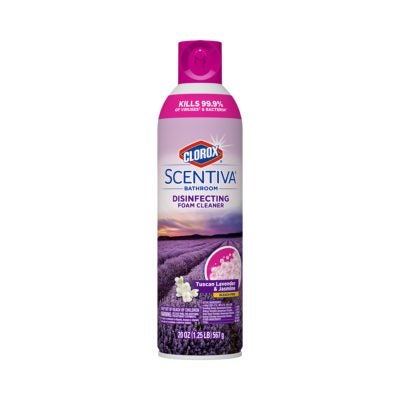– OR –
Ingredients Inside :Clorox® Scentiva® Bathroom Foam Cleaner (Aerosol) (Tuscan Lavender & Jasmine) 44600318172
-
Product Name and UPC: Clorox® Scentiva® Bathroom Foam Cleaner (Aerosol) (Tuscan Lavender & Jasmine) 44600318172
-
Brand: Clorox
-
Country: United States

Product Name and UPC: Clorox® Scentiva® Bathroom Foam Cleaner (Aerosol) (Tuscan Lavender & Jasmine) 44600318172
Product Ingredients
- Water
- Water, also sometimes listed on product labels as aqua, is the most widely used of all solvents. It is a colorless, odorless and flavorless liquid and serves as the base of many cleaning products.
- Butane (Propellant)
- Butane is a gas that can be easily liquified, sometimes used as a propellent in aerosols.
- Tetrapotassium EDTA
- Tetrapotassium EDTA (ethylenediaminetetraacetic acid) is used to remove soap film and hard water scale in a wide range of cleaning products, including hard surface cleaners, liquid soaps, laundry detergents, antimicrobial cleaners, and commercial products. It also helps maintain the product's appearance, and prevents deterioration.
- Isobutane (Propellant)
- Isobutane is an organic substance with a low boiling point, which is used as an aerosol propellant.
- Butoxydiglycol
- Butoxydiglycol is used as a solvent in cleaning products to help dissolve stains and soils.
- Propane (Propellant)
- Propane is an organic substance with a low boiling point, which is used as an aerosol propellant.
- Alkyl C12-16 Dimethylbenzyl Ammonium Chloride
- Alkyl C12-16 dimethylbenzyl ammonium chloride is a quaternary ammonium compound (or "quat") and is added to products as cleaning agents, or as antimicrobial agents in EPA-registered disinfecting cleaning products.
- C9-C11 Alkyl Polyglucoside
- C9-C11 alkyl polyglucoside is a mild surfactant used in household and commercial cleaning products. It is known for its foam-boosting ability, lack of streaking and easy rinsing.
- Citric Acid
- Citric acid is a natural acid, used as a builder in laundry detergents, dishwashing products, and hard surface cleaners. It is effective in cleaning soap scum and mineral scale deposits left by hard water on fixtures such as toilets, bathtubs and sinks. Builders act like water softeners, to remove calcium, magnesium and other ions found in tap water, that can interfere with the cleaning process.
- Decylamine Oxide
- Decylamine oxide is used in laundry and other cleaning products as a primary cleaner, foam enhancer, stabilizer and thickener.
- Didecyldimonium Chloride
- Didecyldimonium chloride is a quaternary ammonium compound, a group of surfactants used in cleaning products for their antimicrobial activity.
- Dimethyldioctylammonium Chloride
- Dimethyldioctylammonium chloride is quaternary ammonium compound (or "quat") and is added to products as cleaning agents, or as antimicrobial agents in EPA-registered disinfecting cleaning products.
- d-Limonene
- d-Limonene is used in cleaning products to help dissolve stains and soils and as a fragrance component. A member of a class of chemicals called terpenes, d-Limonene is obtained from the rinds of citrus fruits. It has been identified as a potential allergen by the Scientific Committee on Consumer Safety, an advisory board to the European Union..
- Ethanol
- Ethyl alcohol (or ethanol) is a solvent that dissolves other cleaning product additives, such as fragrances. It is also used as an antimicrobial additive in some hard surface cleaners to kill or inhibit growth of disease- and odor-causing microbes.
- Fragrance
- Fragrances and perfumes are mixtures of fragrant essential oils, aroma compounds, fixatives and solvents. They are used in cleaning products to add a particular scent (lavender, lemon, etc.) to clothes and homes, and to mask unpleasant odors. Clorox provides a separate list of all the fragrance ingredients used in our household and professional cleaning, disinfecting and laundry products.
- Quaternium-24
- Quaternium-24 is a quaternary ammonium compound, a group of surfactants used in cleaning products for their antimicrobial activity.
- Sodium Benzoate
- Sodium benzoate is a well known preservative found in nature, primarily used in food products to keep them from spoiling. It is also an effective anti-corrosion compound.
- Sodium Metasilicate
- Sodium metasilicate is often used as a corrosion inhibitor when added to detergents to protect metal components of washing machines. It also prevents soils from depositing on fabrics during the wash cycle.
Clorox lists all fragrance components identified as potential allergens by the Scientific Committee on Consumer Safety, an advisory board to the European Union, when they are present at a concentration of more than 0.01 percent or greater in the product and provides a separate list of all the fragrance ingredients used in our household and professional cleaning, disinfecting and laundry products.
Product ingredients are listed based on the most current information available; please check back periodically for formulation updates. If you have questions regarding a product or the ingredient listing for a product, please contact us for additional information.
